The Essential Guide to Sustainable Living
Updated: Apr. 15, 2024

Sustainable living is good for the planet—and for you. Read on to learn how to avoid plastic, reduce your carbon footprint and be more eco-friendly in general.
People have different reasons for trying to adopt a more sustainable lifestyle. Some do it to help lighten their load on the environment. Others are trying to save money, and still others do it to live healthier. But whatever your initial reasons for pursuing sustainable living and trying to reduce your carbon footprint, you need to figure out where to start—then learn how to improve, one step at a time.
(April 22 is Earth Day, a day to not only celebrate our love of the natural world but to acknowledge our duty to take care of and protect it.)
“If you don’t feel like your individual contributions are making a difference, think again,” says Erin Levine, certified composting professional and resource recovery manager at World Centric, a leading compostable tableware company. “If everyone were doing the same thing, for example refusing plastic straws, imagine the difference that would make. Actions do make a difference.” Whether you’re practicing sustainable living by taking a recycling quiz, learning how to recycle, finding genius ways to recycle anything or skipping meat one day a week, any and all changes you make will go far toward making your life and the life of the planet healthier.
Even better: There are tons of places you can start your sustainable living journey. Here, discover all the different ways you can make your life more sustainable.
While you’re at it, also explore these Earth Day facts.
On This Page
What is sustainable living?
Living more sustainably, or cultivating an awareness of how your actions and choices impact the environment and then adjusting your actions accordingly, has many benefits. “By living more sustainably you are lightening your load on our environment. When you choose to behave, consume and regenerate with nature in mind, you avoid unnecessary burden to our already stressed ecosystems,” Levine explains.
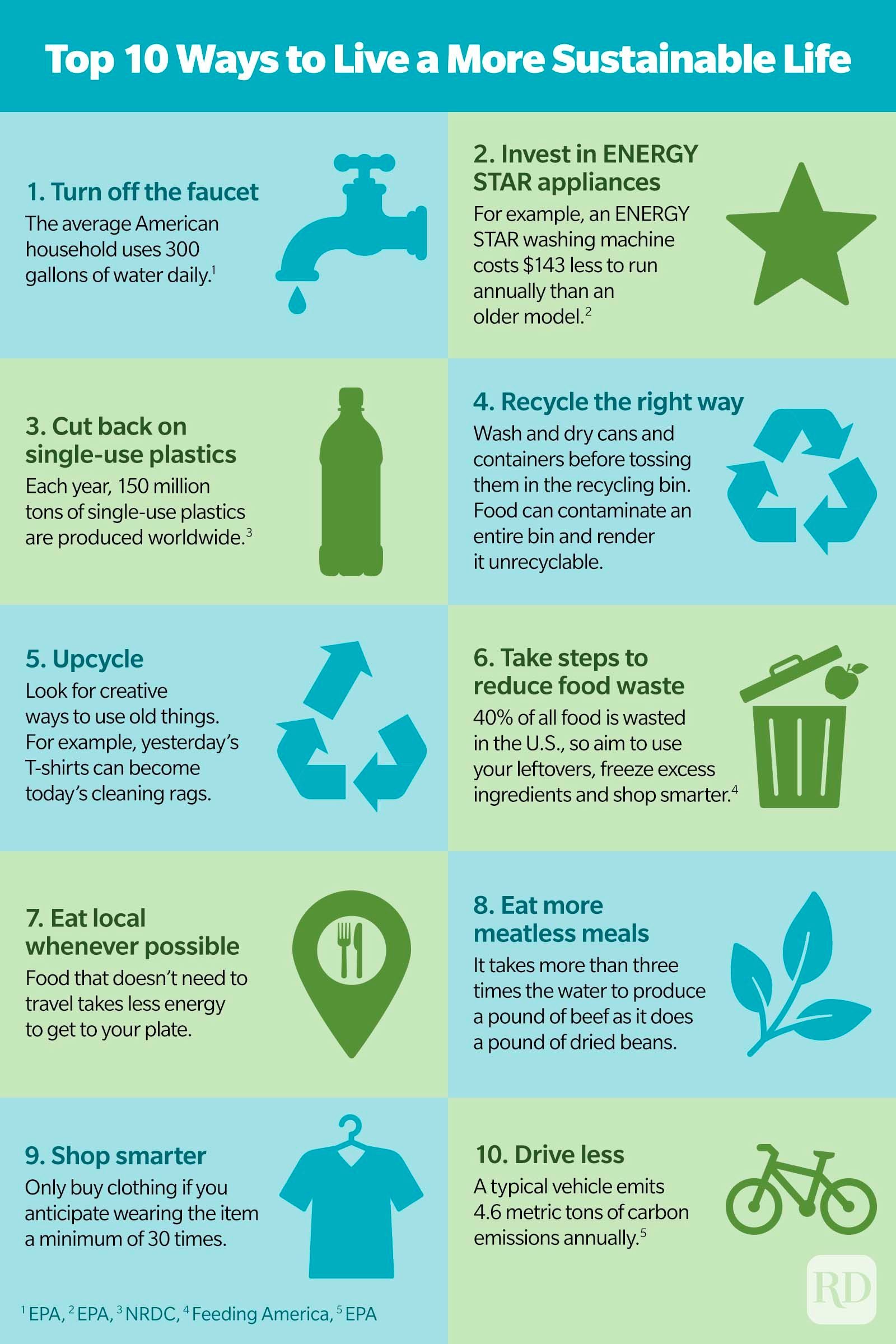
The perks of reducing your consumption and the waste you produce also extend to the personal level. “You will be healthier when you opt for sustainable choices, as you will be closer to natural things. You will find you are more mindful and appreciate what you have,” Levine adds. “You may even find that you save money by avoiding buying in excess or buying secondhand items.”
Once you get on the path to a more sustainable lifestyle, you may even find yourself drawn to zero-waste living. “The technical definition of zero-waste living is not sending anything to a landfill,” says Kathryn Kellogg, author of 101 Ways to Go Zero Waste and chief sustainability officer at The One Movement. “But I like to take a more holistic view. There’s so much more we can waste, like time, energy and resources, beyond what we put in our trash can. For me, it’s about completely writing waste out of existence.”
Why is sustainable living important?
In short, sustainable living can slow climate change, which is desperately needed. NASA shares these following facts to show that climate change is real:
| 1. | The earth’s average surface temperature has risen about 2 degrees since the late 19th century. |
| 2. | 2016 and 2020 are tied for the warmest years on record. |
| 3. | The top 100 meters of the ocean have warmed more than 0.6 degrees since 1969. |
| 4. | Between 1993 and 2019, the Greenland ice sheet lost an average of 279 billion tons of ice per year. |
| 5. | The rate at which sea levels are rising worldwide over the last two decades is double that of the last century. |
While this is enough to induce climate anxiety in anybody, taking steps to live more sustainably on a daily basis and spreading this message to your community can help soften the blow. “While individual actions do matter, it’s more impactful when they’re amplified by a mass of people,” asserts Kellogg.
How can you live a more sustainable lifestyle?
Living a more sustainable lifestyle starts with the little changes you can make in your everyday life. Read on for more than 50 tips on how to live a sustainable lifestyle.
How to live more sustainably at home
Many of the simplest sustainable living ideas are those that take place in your house and in your day-to-day life. Here are some of the most common as well as most impactful changes you can make.
Conserve water

According to the Environmental Protection Agency (EPA), the average American family uses more than 300 gallons of water in their home every day, with the shower, toilet, washing machine and faucet making up roughly 80%. The first step to conserving water in your house is to be more conscious of how much you’re using and wasting while completing household tasks.
Other habits to get you started on conserving water: When you’re shaving, brushing your teeth or doing the dishes, don’t keep the faucet running the entire time. If your shower takes a while to heat up, use a bucket to catch the cold water and then use it to water plants or clean. And if any of your water-using appliances, such as your washing machine or dishwasher, are more than 20 to 30 years old, consider replacing them with newer models, which are much more efficient when it comes to water use.
Conserve energy

Similar to water usage, most people don’t realize how much energy they are using in their homes—but taking steps to conserve it is good for the environment (plus takes some pressure off your wallet). When it comes to figuring out how to conserve energy, the EPA and manufacturers have done a lot of the work for you. If you’re shopping for light bulbs or appliances, look for the blue ENERGY STAR logo, which means the product has been independently certified as using less energy and reducing emissions enough to curb the air pollution the product is producing. This simple step can have big benefits: According to the EPA, energy-efficient light bulbs that are certified by ENERGY STAR use 70% to 90% less energy than regular incandescent bulbs, and an ENERGY STAR washing machine costs $143 less to run annually versus a model from 2000.
Also smart: Hang-dry your clothes outside, set your refrigerator and freezer to the correct temperatures (just below 40 degrees and zero degrees, respectively) and make sure the doors of both appliances are sealing properly and staying closed.
Ditch single-use plastics
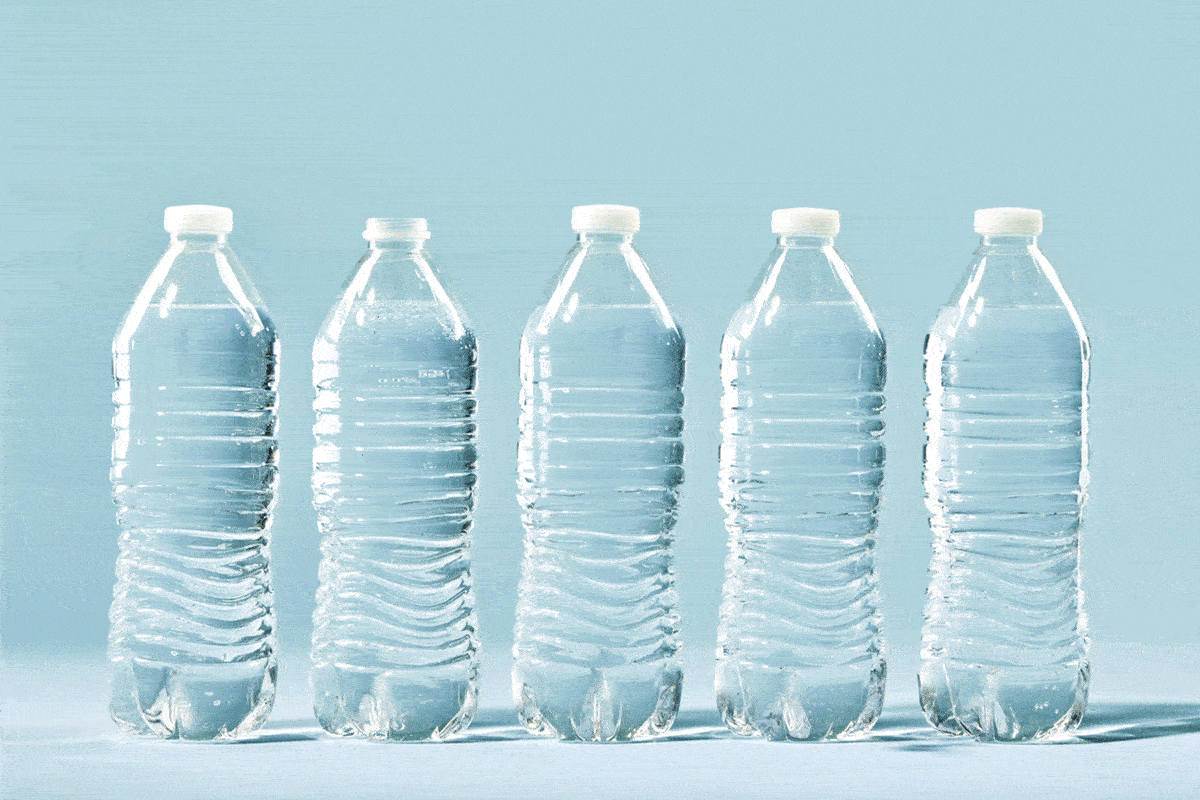
One of the easiest ways to reduce plastic pollution is to avoid single-use plastics. According to the Natural Resources Defense Council, single-use plastics are goods made primarily from fossil fuel–based chemicals that are meant to be discarded immediately after use. These include plastic straws, plastic grocery bags, candy bar wrappers, plastic bottles and other products. And while there are some plastic products that are important and necessary, such as surgical gloves, half of the 300 million tons of plastic we produce worldwide on a yearly basis comes from single-issue products.
Striving toward living plastic-free can drastically reduce ocean pollution. “Bring your own reusable water bottle, shopping bag, straws and coffee mugs. If you make it a habit to bring along your own stuff, it can eliminate a lot of waste,” says Levine. “This is a simple and easy way you can start to be more mindful of your footprint.”
Recycle
“Recycling can be a great way to live more sustainably,” says Levine. While it’s true that recycling can help you be more eco-friendly, there are rules that need to be followed to prevent your recycling from winding up in a landfill. “I would caution people not to ‘wish-cycle,’ which is placing an item in the recycling bin without knowing whether or not it’s actually accepted,” Levine adds. In general, paper, cardboard, aluminum and other non-scrap metals and rigid plastics can be recycled, while some carriers accept glass and Styrofoam as well. “Try to rinse and dry your containers to ensure they are clean to improve the quality of the recyclable item, like a metal can or milk jug,” Levine says.
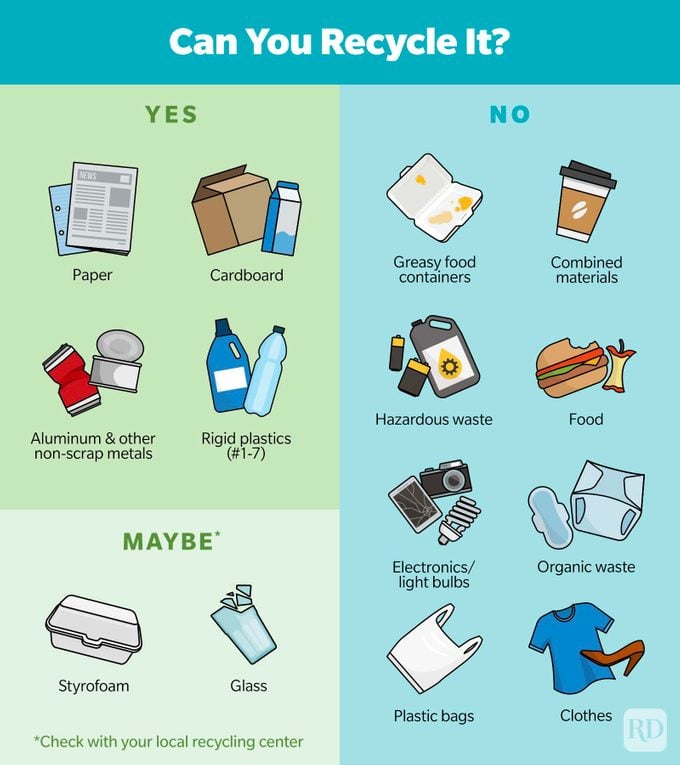
Levine suggests checking what’s on your waste hauler’s acceptance list. “Then, once you know what they accept, you can start to tailor your consumption based on that information, for example, buying an item in glass instead of plastic,” she says.
Sell unwanted items
Whether you need to get rid of old clothes, electronics or other household items, it’s easier than ever to sell your old and unwanted stuff. That’s because there are so many online marketplaces where you can safely reach people who are seeking the exact things you’re hoping to bid goodbye.
If you want to sell your cast-offs, first find a reputable marketplace that has few complaints and bad reviews online. Then familiarize yourself with the user policies—some sites are focused on specific items or have unique return policies or fees—and their payment system, as some have the option to pay via credit card while others may not. Finally, price your item by visiting other marketplaces to determine the going rate and how popular similar items are.
Upcycle
Unlike recycling, in which waste products are broken down and converted into reusable materials, upcycling involves taking a product and turning it into something else of equal or higher value. And depending on your level of creativity, almost anything can be upcycled! You can do something as simple as using old T-shirts as cleaning rags or empty glass jars as food storage, or something as artistic as transforming broken furniture into stylish home decor.
Make your own cleaning products

“When I first started living more sustainably, I wasn’t really doing it from a save-the-planet perspective,” shares Kellogg. “I was making a lot of these changes to save money and have more control over the products and ingredients I was bringing into my home. I had a really bad hormonal imbalance, and things like plastics, cleaning products and beauty products have a lot of endocrine disruptors in them.” Indeed, making your own cleaning products not only reduces your environmental footprint, but this sustainable living idea can help improve your health as well.
To do so, you can use baking soda and vinegar to make a variety of different cleaning solutions. You can also repurpose other household products, such as fabric softener, dish soap and hydrogen peroxide, into homemade cleaners. And if you don’t trust yourself to mix up your own cleaning supplies, there are eco-friendly products on the market. Some of our favorite sustainable cleaning supplies include Method, Grove Co. and Dr. Bronner’s.
Below, see the top ways to be more sustainable at home.
How to eat more sustainably

In addition to the choices you make around the house and the products you use, the food you eat can also help you live more sustainably. In general, sustainable foods are considered those that are harvested from the environment in a way that doesn’t hinder the environment’s ability to continue surviving and producing that food in the future. What’s more, sustainable foods are those that are grown, manufactured or produced by workers and/or animals that are treated fairly and ethically.
One simple way to eat more sustainably is to only buy food products that are Fair Trade Certified, Food Alliance Certified or Rainforest Alliance Certified. These are all organizations that ensure the food is produced using sustainable agriculture practices in safe and healthy working conditions. The following strategies will help as well.
Reduce food waste
Working to reduce the amount of waste you produce and send to landfills is one of the most powerful steps you can take to live a more sustainable life—and food waste is at the top of that list. In fact, food waste that winds up in landfills contributes to 8% of global carbon emissions, plus gives off methane gas, a greenhouse gas 87 times more potent than carbon dioxide. And Americans, unfortunately, are playing a huge role in that buildup: The food insecurity nonprofit Feeding America estimates that 40% of all food is wasted in the U.S.
To help cut down on your family’s food waste, always shop with a list, since impulse buys are more likely to be wasted. Look for compostable packaging when you can, or try to stick to fresh, not processed and packaged food (which will be healthier for you anyway). Once you get home, try to plan out your meals for the week (or even better, do this step before you hit the supermarket). If you have leftovers, eat them the next day or find a creative way to repurpose them.
Eat organic and local when possible
Once you’ve made your list and you’re hitting the grocery store or farmers market, choosing organic and/or local produce, meats and eggs whenever you can is going to help you eat more sustainably. Organic foods are grown without the use of synthetic chemicals like man-made pesticides and fertilizers, which makes them not only better for you but also better for the environment in which they are grown. Local foods, meanwhile, don’t have to travel as far to get to you, meaning fewer fossil fuels are produced in their transport.
Go plant-based
“Eating a plant-based diet is better from a resource perspective, a land management perspective, a water perspective, greenhouse gases, it just goes on and on and on,” asserts Kellogg. Indeed, if the entire country suddenly went vegan, it would reduce food-related emissions by 73% and water usage by 25%. “It takes a little over 1,800 gallons of water to produce a pound of beef but only 500 gallons of water to produce a pound of dried beans,” Kellogg says. “To put that even further into perspective, you could have three burger patties versus 24 cups of cooked beans for the same water footprint.”
If you’re not used to building entire meals around plants, start by trying to cut out animal proteins one day a week and go from there.
Choose sustainably farmed fish
In the same way that sustainable food is food that is produced and harvested without hurting the environment, sustainable fish is seafood that is fished without hurting the ecosystem. Many commonly used practices, including overfishing, blast fishing and bottom trawling, can throw the ecosystem of the area out of whack, hurting the type of fish that’s being farmed as well as other species that are caught in the crossfire.
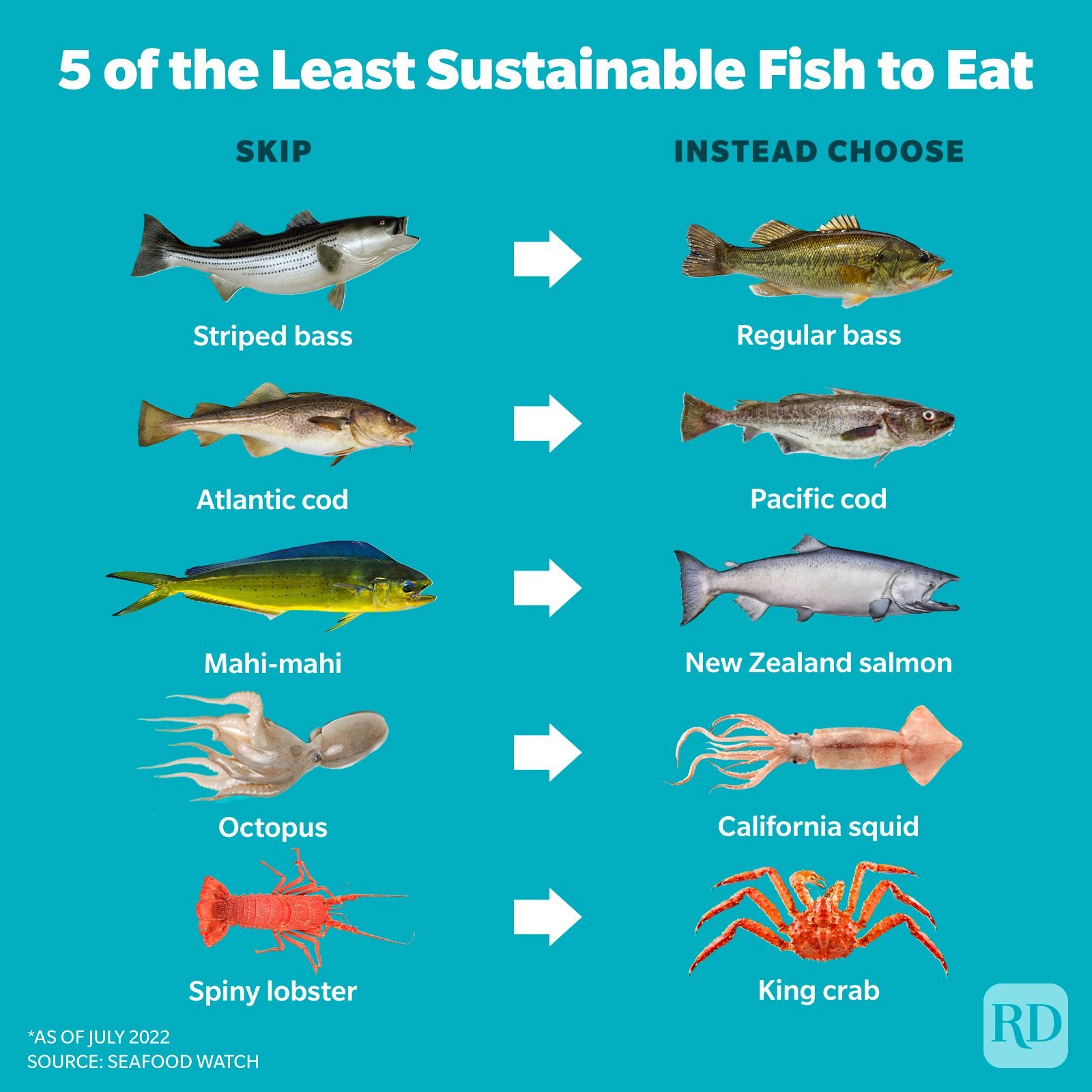
To make a habit of buying sustainable fish, ask at restaurants, grocery stores and fish markets if they have any sustainable seafood. You can also refer to the Seafood Watch consumer guides, which provide up-to-date information on the types of seafood that are being fished sustainably, according to their standards.
Compost
In a nutshell, composting is the process of layering your kitchen scraps and yard waste in a bucket or other container until it decomposes and becomes something you can add to the soil in your garden. By doing so, you’ll avoid creating the potential greenhouse gasses that food scraps give off when landfilled. “In return, you’ll create a rich soil that can retain moisture and provide plants with high-quality nutrients and is a great substitute for chemical fertilizers,” Levine says.
“If you want to start composting, start by separating your food scraps into their own container,” says Levine. Things you can compost include fruit and vegetable scraps, eggshells, coffee grounds, tea bags, grass and plant trimmings, dried leaves and wood and shredded paper. “You can make it easy by placing a bin right next to you when you prepare a meal and place your scraps in the bin,” she adds. “Make sure you empty it regularly and start to think of the food scraps not as waste, but as a valuable resource that will become nature’s fertilizer.”
Grow your own food
Arguably the most sustainable food you can eat is the food that’s grown in your own backyard (or on your balcony or windowsill). It doesn’t need to travel at all to get to you, which reduces its carbon footprint, and you won’t be using chemical-based pesticides—plus you’ll save money and eat more fruits and vegetables as a result.
To start growing your own food, first consider the space you have, the amount of sun it gets and the climate you live in, as these will determine which foods will thrive in your garden. Then simply gather your tools and seeds and get planting! Some of the fastest-growing foods that are great to start with include beets, kale, spinach, scallions and zucchini.
Keep it going by learning more about sustainable food at the links below.
How to shop more sustainably
Put your money where your mouth is when choosing which companies to support. This can go a long way toward encouraging manufacturers to continue or begin to build sustainable business practices, Kellogg says. Here are some of the best ways to do so.
Support sustainable fashion

The first place you can make an effort to shop more sustainably is the clothes you buy. Sustainable clothing brands are those that prioritize fair labor practices and eco-friendly manufacturing processes. Buying from these brands, as opposed to fast fashion brands that produce cheap, trendy clothes in often unsustainable ways, sends a message that companies looking for customers should follow suit. “I try to look for brands that are prioritizing their workers by paying a fair living wage and providing good working conditions,” says Kellogg.
To find out if brands are using sustainable production practices that support the environment, look for them to be Fair Trade Certified, which should appear on their website and on the tags in the clothes themselves. You can also look for a Bluesign tag, which means that the textiles used to create them were produced in a responsible and sustainable way. To ensure you’re buying from sustainable and eco-friendly brands that are treating their workers fairly, you can also look for accreditation on their website from the Fair Labor Association. Keeping an eye out for these certifications will help you avoid companies that are using greenwashing—making it look like their business practices are more sustainable than they are.
Another smart practice: “When you do need to buy something new, it’s really important to make sure it’s something you’re going to love and you’re going to use,” Kellogg says. “The going rule is not to buy unless you’re going to get 30 wears out of that item.”
Give life to old clothes
If you’re tired of a piece of clothing or you’ve grown out of it, you have many options for giving it a second life that will help reduce waste. First, for items that still fit, you can consider upcycling them, for example by dying a shirt or patching or embroidering a pair of pants. If an item no longer fits, consider turning it into a tote bag or a quilt.
For people who don’t consider themselves creative, consider a clothing swap. “When it comes to shopping more sustainably one of the best things you can do is shop your closet,” says Kellogg. “I love to host clothing swaps with friends and look on the secondhand market.” There’s also the option to donate clothes to a local organization that accepts them.
Shop sustainable brand marketplaces

It’s not just clothing companies working to make their production and supply chains more sustainable: There are companies you can support that are making all sorts of things, from eco-friendly cleaning products to snacks, and one of the easiest ways to find them is through a brand marketplace that supports these business practices. Here are some you can check out:
- Grove Collaborative: Natural and sustainable cleaning, home, beauty and personal care products
- Thrive Market: Natural and organic food, home and beauty products
- Hive Brands: Sustainable food, home, wellness and pet products
- Imperfect Foods: Sustainable groceries
- The Flowry: Sustainable fresh flowers
Choose sustainable furniture
The EPA has numerous standards that furniture manufacturers must achieve in order to be considered a green product. In general, sustainable furniture is pieces that have been built ethically, ideally from natural materials and without the use of synthetic chemicals or substances, and have been built to last. Some companies are even making furniture from recycled materials, slashing the amount of waste that can wind up in landfills as a result of the production or use of the product. To see if a piece of furniture was made sustainably, look for certifications on the company’s website from any of the following organizations: Cradle to Cradle, Better Cotton Initiative, Fair Trade USA, Forest Stewardship Council, Global Recycled Standard, OEKO-TEX and Tencel.
One place you may want to pay close attention to this is your mattress. After all, you spend a third of your life on your mattress, so choosing one that was made without harmful chemicals and with natural materials (aka an organic mattress) is smart. For a regular spring mattress, look for one certified by the Global Organic Textile Standard. For a foam mattress, look for one certified by the Global Organic Latex Standard.
Seek out sustainable shipping and packaging
Whether you’re ordering things online or mailing out gifts around the holidays, the materials you use to package your products and the method used in shipping may be contributing to environmentally harmful practices. When you are shipping things, try to avoid wasted space as much as you can, and choose packing materials made from just one material, such as 100% recycled cardboard boxes and newspaper for padding—bonus points if you have these things at home already and are reusing them instead of purchasing new. When possible, select the slowest shipping method for purchases, as this will use existing routes and won’t contribute to increased fossil fuel emissions (plus, it’s typically cheaper).
Learn more about shopping sustainably in the stories below.
How to travel more sustainably
From your daily commute to the vacations you take with your family once a year, every time you start the car or get on an airplane there are environmental and social impacts. Here are some of the ways you can travel more sustainably.
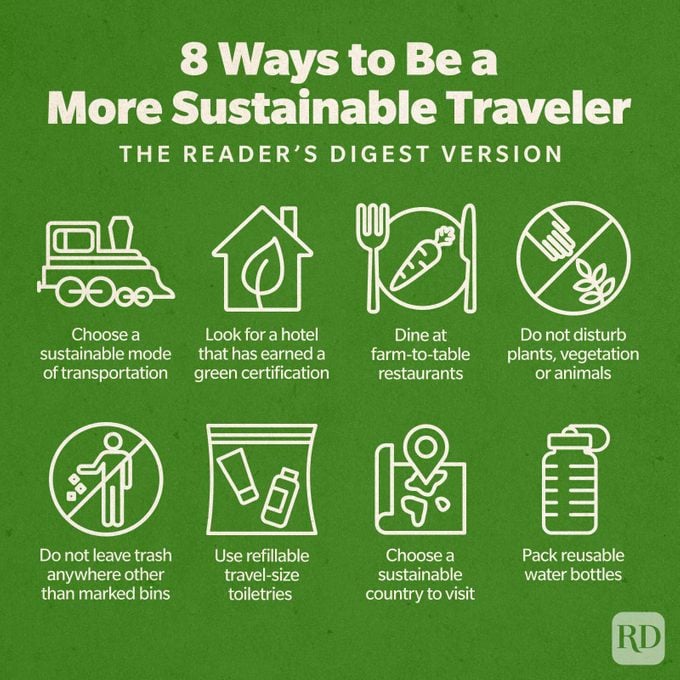
Drive less
Take public transportation when you can, or walk or bike, as the latter are emissions-free. Another option, if those aren’t doable where you live, says Kellogg, is to try to carpool as much as possible, because the fewer cars on the road the better. Choosing a fuel-efficient car for your daily trips to work or the grocery store will also help you save money on gas while also reducing harmful emissions. A typical vehicle emits 4.6 metric tons of carbon dioxide annually, according to the EPA. Taking steps like keeping your tire pressure up, driving the speed limit and avoiding stop-and-go traffic will help you get better gas mileage, while using public transportation, keeping your windows up on the highway and joining a gas station loyalty program can help you save on gas. California has already gotten a head start on reducing fuel emissions by implementing a gas car ban, which will take full effect in 2035.
Vacation smarter
“Take your next vacation a little closer to home and try to aim for only one fly a year,” suggests Kellogg about how you can make your family trip more sustainable. When you’re selecting a hotel, look for one that has earned a green certification, such as LEED, Green Globe or Beyond Green. Then during your trip, try to dine at local restaurants and buy from local vendors as much as you can.
How are the government and EPA supporting sustainability?
While there is a long way to go at the government level, the federal and state governments in the United States have been taking steps to support sustainability. On the social level, the recent passage of the Uyghur Forced Labor Prevention Act prevents the importation of any products produced by or in association with the Xinjiang Uyghur Autonomous Region of the People’s Republic of China, where there have been numerous suspected human rights violations to workers. The California Transparency in Supply Chains Act requires retailers and manufacturers doing business in California (the U.S.’s largest consumer base) to disclose on their websites their efforts to eradicate slavery and human trafficking from their supply chains.
On the environmental side, the Clean Air Act, most recently amended in 1990, addresses air pollution by setting standards to regulate the emission of hazardous air pollutants, while the Clean Water Act, dating back to 1972, regulates the discharge of pollutants into the water. Other EPA laws include the Resource Conservation and Recovery Act, which gives the EPA control over hazardous waste, and the Endangered Species Act, which provides a program for the conservation of threatened and endangered animals, plants and their habitats. In August, the Congress passed the Inflation Reduction Act, which included $369 billion designated for clean energy initiatives. These include tax credits to support the use of renewable power, a program that rewards companies for cutting methane emissions and help for individuals who want to purchase electric vehicles or make their homes more energy efficient. It marks the biggest climate investment in U.S. history.
Meanwhile, there are numerous innovative recycling strategies being tested and implemented that will change the future of recycling, and there’s plenty we can learn from the most eco-friendly countries in the world.
Inspired to do even more? Read on to learn about the creative ways individuals are drawing attention to climate change and doing their part to promote a more sustainable world.
Sources:
- Erin Levine, certified composting professional and resource recovery manager at World Centric
- Kathryn Kellogg, author of 101 Ways to Go Zero Waste and chief sustainability officer at The One Movement












